ワーキンググループ紹介
①アクティブ・ラーニングWG
What is active learning? アクティブ・ラーニングとは?
Active learning involves non-passive engagement by students in the learning process. It is an approach to instruction in which students dynamically engage with the material they study through reading, writing, speaking, listening, and reflecting. “Students must do more than just listen: they must read, write, discuss, or be engaged in solving problems. Most important, to be actively involved, students must engage in such higher-order thinking tasks as analysis, synthesis, and evaluation. Within this context, it is proposed that strategies promoting active learning be defined as instructional activities involving students in doing things and thinking about what they are doing” (Bonwell & James 1991).
アクティブ・ラーニングは学習過程における学生の受け身ではない学習への関わりです。読み、書き、話し、聞き、考えることを通じて、学生がダイナミックに学習に向き合う教授法の1つのアプローチです。“学生は、傾聴するだけでなく、読解したり、記述したり、問題解決のために討論したりする。学生が積極的に学習に向かう際に最も重要なことは、分析、統合、評価などを通して、より高度な思考タスクに積極的に取り組むこと。この文脈においては、アクティブ・ラーニングを促進する手法とは、学生が何かを行うように、また学生が自分自身の行っていることを考えるように促す教授方法である。 (Bonwell & James 1991)
Initial Research Questions 初期の研究課題
- What are preferred practices for AL teaching strategies (ALTSs) at MIC?
アクティブ・ラーニングのツールで好んで使われているものは何か? - What is the connection between AL strategies with MIC’s critical thinking (CT) goals?
アクティブ・ラーニングとクリティカル・シンキングの発達に相関性はあるか? - Is there a connection between AL strategies and the discipline in which they are used?
教科によって用いられているツールの傾向があるか?
Pre-2016 Efforts 2016以前の活動
- Compilation of initial list of active learning teaching strategies (ALTSs), refined through informal discussion with faculty
アクティブ・ラーニングツール(ALTS)のリストアップ:教員との対話によるリストは洗練された。 - Class observations
クラス見学 - Interviews with Instructors
教員へのインタビュー - Further refinement of ALTS list, development of “matrix” – a typology for classifying ALTSs
ALTSリストから、カテゴリーを見出し分類した。
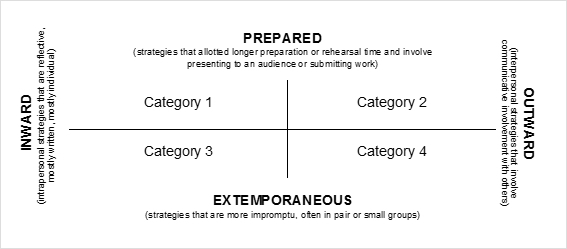
ALWG GOALS アクティブ・ラーニングWGの目標
Complete 完了
- Identify and categorize AL teaching strategies in use at MIC
本学で使用されているALの手法や活動を特定して、カテゴリー別に整理する - Develop questionnaires for faculty and students to access type and quantity of AL and self-directed learning at MIC – to be given at end of each semester
学期毎に実施する教員へのALの手法や学生の自主学習に関するアンケートを作成する
In progress 進行中
- Determine AL “best” teaching practices (through results of AL questionnaires, interviews, class observations)
アンケート、インタビュー、授業見学を通じて、効果的なALの手法を特定する - Share AL teaching practices via faculty development seminars
FDを通じて、有効なALの手法を学内の教員に周知する
Future action 今後
-
Develop a documentation system for ALTSs
アクティブ・ラーニングの手法を記録できるシステムの構築 - Investigate the relationship between AL and the development of critical thinking skills
ALとクリティカル・シンキング能力の関連性を調査する - Investigate further into active learning practices from the student end
学生の視点からのALの手法を更に調査する
②クリティカル・シンキングWG
The task of the Critical Thinking Working Group (CTWG) is to develop a test for MIC students that will evaluate the development of their critical thinking skills. Critical thinking is the ability to think clearly and rationally about what to do or believe. Good critical thinkers use the rules of good reasoning, including formal and informal logic, to make careful judgements about what is true or false, reliable or unreliable, and reasonable or unreasonable. MIC prides itself on helping students to develop their critical thinking skills through active learning in small classes. From their very first class, students are encouraged to adopt a critical perspective to their studies, thereby learning how to think more carefully about themselves and the world they live in. The MIC critical thinking test helps faculty to evaluate this development and adjust their teaching accordingly and helps students to visualize their progress and grow in confidence as the critical thinkers increasingly required by our globalized world.
クリティカル・シンキングワーキンググループ(CTWG)の役割は、本学学生のクリティカル・シンキング能力の発達を測るテストの開発です。
クリティカル・シンキングとは、明瞭かつ理論的に、何をすべきか、何を信じるかを考える能力です。何が真実か嘘か、信頼性があるのかないのか、合理的なのかそうでないのかを注意深く判断するために、その能力に優れている人は、公式的及び非公式的な論理法などの理論のルールを巧みに使います。
本学は、少人数クラスでのアクティブ・ラーニングを通じて、学生がクリティカル・シンキング能力を養成することに自信をもって取り組んでいます。1年次の最初の授業から、本学学生はクリティカルな物の考え方を通じて勉強するように促されていて、自分自身と自分を取り巻く世界についてより注意深く考える能力が身に付きます。
グローバル化したこの世界で、クリティカル・シンキング能力がますます必要となっています。そんな中、本学のクリティカル・シンキングテストによって、教員はこの能力の発達を測ることができ、この能力を育成するように授業を展開させることができます。また、テストのおかげで、本学学生は自信をもって、その能力の発達及び成長を視覚化することができます。
③eポートフォリオWG
目的
e-ポートフォリオWGの活動目的は、本学でのe-ポートフォリオ使用の普及・改善です。
e-ポートフォリオとは?
学生が授業で学んだこと、あるいは得た情報を、全てファイル(ワード、エクセル、パワーポイント、PDF、写真など)として記録・管理できるインターネット上のスペースです。授業で取り組んだ課題や研究論文などをまとめてインターネット上に保存・整理することで、学生は自己の学修を振り返り、その後の学修に活かすことができます。
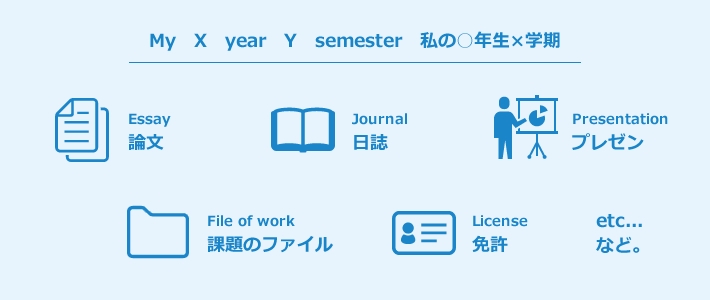
本学でのe-ポートフォリオ・システム
本学のe-ポートフォリオ・システムの構築には、本学ですでに使用しているGmailアカウントと連携したMoodleとMaharaを採用しました。国際教養学部では、これまですでに学習管理システムであるMoodleを授業等で利用していましたので、AP事業でe-ポートフォリオ・システムを導入するにあたり、このMoodleと連携できるMaharaをそのプラットフォームとしました。これにより、学生は自らの学修成果をMahara上に保管・記録することで、過去の学修成果を可視化し、将来の学修に活かすことができるようになりました。
Moodleとは、インターネット上のオンライン学習管理システムソフトのことで、教員はMoodleを通じて授業用のウェブサイトを作り、授業で使う資料、課題、アクティビティ、クイズなどを作成し、オンライン上に保存しておくことができます。また、Moodle上で成績管理も可能です。学生はインターネットがあれば、いつどこにいてもMoodleにアクセスして、教員が保存、あるいは用意した授業の資料や課題などを見ることができます。Maharaとは、様々なファイルや写真、その他データをアップロードし、整理・保管が容易にできるソフトです。学生が本学での学修記録を整理し、保存できることから、本学のe-ポートフォリオ作成のためのプラットフォームとして採用しました。
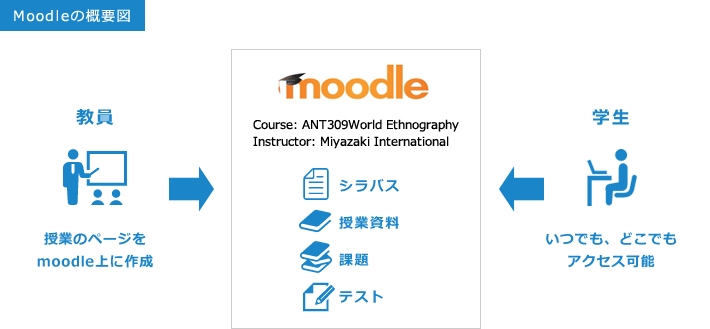
本学でのe-ポートフォリオ活用の一例
前述の通り、学生はMahara上にe-ポートフォリオを作成することで、本学での4年間の学修成果(過去の論文やプレゼンテーション、収集した資料など)を記録・保管することでき、必要に応じて自己の学修を振り返ることができます。言い換えると、自己の学修成果を可視化することで自らの強い点、弱点、あるいは成長を確認することで、将来のさらなる発展へと繋げることができるわけです。AP事務局では、学生のe-ポートフォリオの効果的活用を推進、サポートするために、オリエンテーションを適宜行うとともに、当初はその作成指導を行います。もちろん、基本的知識、操作方法等を十分理解したあとは、学生は自由に自らのe-ポートフォリオを構築していくことができます。
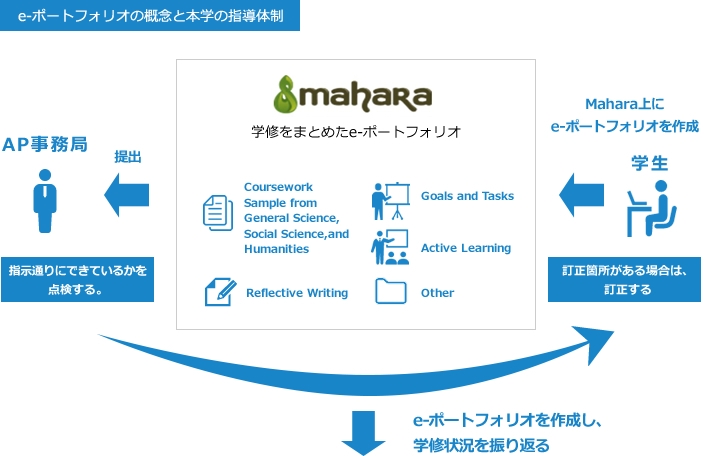

e-ポートフォリオWGの活動
e-ポートフォリオWGは、学生のe-ポートフォリオ利用推進のために、学生に対してe-ポートフォリオのオリエンテーションを行う一方、教員に対してもFDの一環としてワークショップを開き、MoodleとMaharaの概要及びその使用方法等を説明しました。全学挙げてe-ポートフォリオの効果的活用を推進するためです。新入生に対してオリエンテーションを行うことはもちろん、必要に応じて、すでにe-ポートフォリオを活用している学生に対して、あるいは、教員に対してもさらなる指導・説明会等を実施していきます。国際教養学部2年次での海外留学や授業の一部でもe-ポートフォリオの利用(課題の提出等に利用)が本格的に始まり、e-ポートフォリオは今後ますますその活用方法が広がっていくものと期待されています。現在、本学での学修成果の充実に資するe-ポートフォリオの使用法も検討中です。
④ルーブリック・ベース・シラバスWG
What is a Rubric?
- Rubrics are tools used for evaluation and assessment. They are schematics that communicate criteria for proficiency.
- Rubrics help instructors clarify expectations. Rubrics help instructors to communicate areas of strength, weakness, and progress.
- Rubrics also help students to understand expectations and instructions. Rubrics help students to see their progress over time.
ルーブリックとは?
- ルーブリックは、評価や測定のために使われるもので、能力や技能をどれだけ習得しているかの評価基準を提示します。
- ルーブリックによって、教員は学生に対して、どんな能力や技能をどれくらい習得すべきかを明確化できます。それによって、強み、弱点、進歩状況を学生に伝えることができます。
- 学生は、何がどのように求められているかが明確に理解できるようになり、自分の進歩を把握できるようになります。
What is the Rubric-Based Syllabus Working Group?
- This working group was created to advance active learning at MIC as a part of the AP grant.
- The long-term goal of the working group is to increase faculty and student communication through a variety of rubrics.
- Some of the functions of the working group are as follows:
-
Faculty Development Meetings
-
Workshops
-
Institutional Rubrics
-
Surveys (faculty & student)
-
Continued Evaluation of the Rubric Process
-
ルーブリック・ベース・シラバスワーキンググループとは?
- このグループはAP事業の一環で、本学のアクティブ・ラーニングを推進するために作られました。
- 長期目標は、様々なルーブリックの有効活用を通じて、教員及び学生間のコミュニケーションを促進することです。
- 以下の活動を主にしています。
- 学内FDの開催
- ワークショップの開催
- 全学的ルーブリックの開発
- 教員及び学生へのアンケート調査
- ルーブリック使用の継続的な評価・検証
Summary of the RBSWG Activities ルーブリックグループの活動表
What We Have Done これまで行ったこと
| Education |
|
|---|---|
| Implementation |
|
| Evaluation |
|
What We are Doing 現在行っていること
| Education |
|
|---|---|
| Implementation |
|
| Evaluation |
|
What We Will Do 今後行うこと
| Education |
|
|---|---|
| Implementation |
|
| Evaluation |
|
Rubric Samples ルーブリック活用の例
1.An adaption of the institutional syllabus
シラバスに導入された全学ルーブリックの応用例(米文学担当教員の事例)
- Students were asked to evaluate themselves against course proficiency objectives at the beginning of the course.
- They then set goals for the end of the semester, based on their strengths, weaknesses, and long-term objectives.
- Students revisited these evaluations at the end of the term
-
学生は授業の初めに、全学ルーブリックを使って自己評価をした。
-
自分の強み、弱点、長期目標に基づいて、全学ルーブリックでの目標を立てた。
-
学期の最後に、再び全学ルーブリックで振り返りを行った。
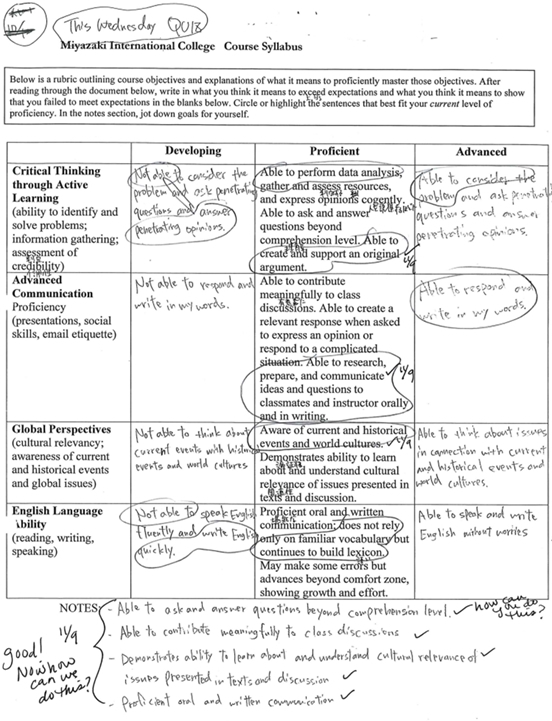
2.An example of an adapted rubric
ルーブリックの応用例(心理学担当教員の事例)
1.Use
It was used in a 3rd & 4th year Abnormal Psychology Course.
3・4年次の授業「異常心理学」に使用
2.Purpose
It was used at the end of the term to help students understand the parameters of the assignment and for evaluating presentations
学生が学期末の課題及びプレゼンテーションの評価基準がよく理解できるように活用
3.Criteria
Criteria for the rubric language was chosen by the teacher but approved by the students in the class.
ルーブリックの評価項目は教員によって作成し、学生の承諾を得た
4.Description of the activity
Students were placed in groups of four and one member of each group presented to their own group, while at the same time other members of the class were presenting to their own small groups. The members of each group were required to use the rubric to give feedback and a numerical grade to the speaker. Student feedback was taken into account, along with the PPT or flier, by the teacher during consideration of the final presentation grade.
学生は4人のグループに分かれ、それぞれのグループの代表が他の学生に対して発表した。それぞれのグループでルーブリックに基づいて相互の発表に対するフィードバックを行い、点数で評価しあった。担当教員は学生からのフィードバック、パワーポイントや配布物の内容などを反映させるようにプレゼンテーションの最終評価を行った。
5.Reflection
The teacher and students found it to be a useful tool. Students said that the clearness of the rubric helped them better understand the parameters of the assignment. The teacher stated that it made grading the presentations much easier. She will continue to use rubrics because they offer good guidelines before the assignment and help to maintain transparency and objectivity during the grading process.
教員及、学生両者ともルーブリックを「役に立つツール」として評価している。学生はルーブリックによってプレゼンテーションの作成基準が明確で分かり易いため課題の評価範囲がよく理解できたと述べた。教員にとってもプレゼンテーションを評価する上でルーブリックが大変役に立つと感じた。また、課題のガイドラインの明確化や評価過程上の透明性及び客観性を担保することができることから、今後もルーブリックを継続活用すると述べた。
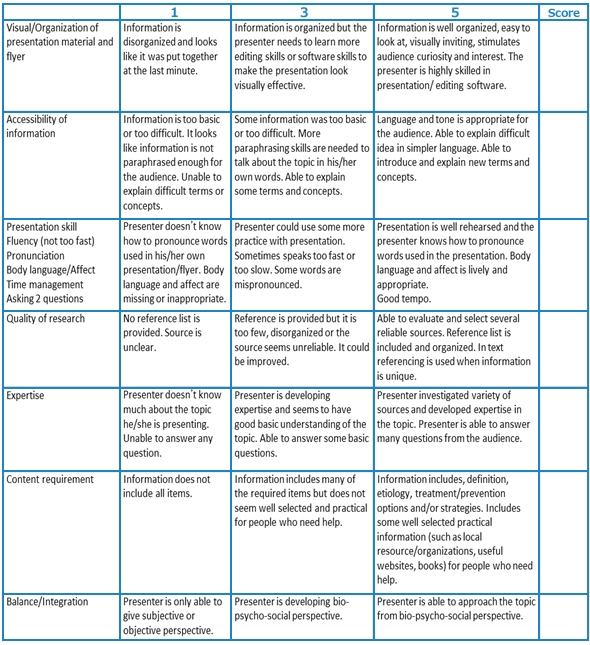
心理学の授業で使用したルーブリックの例





